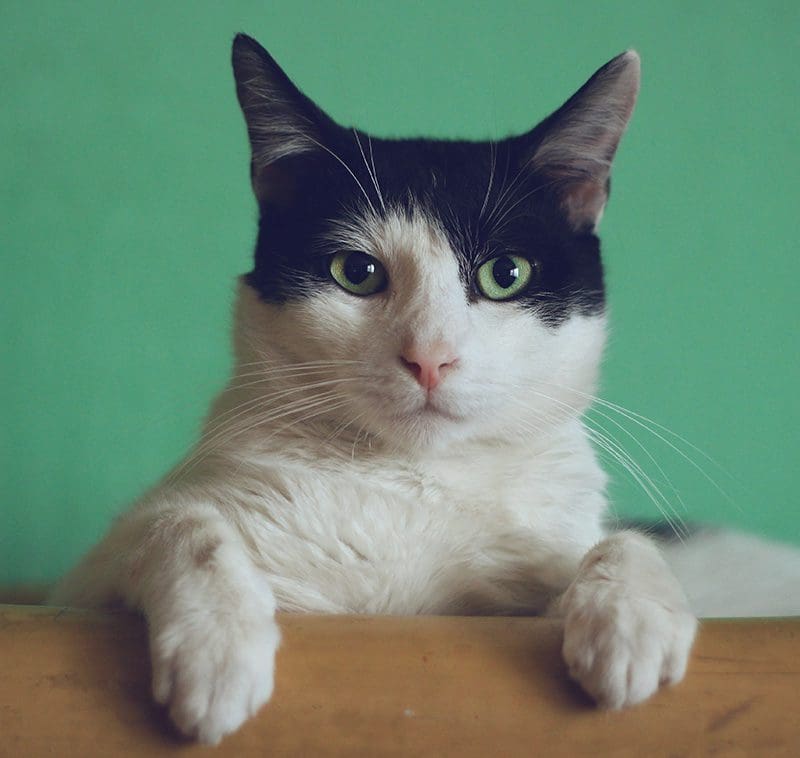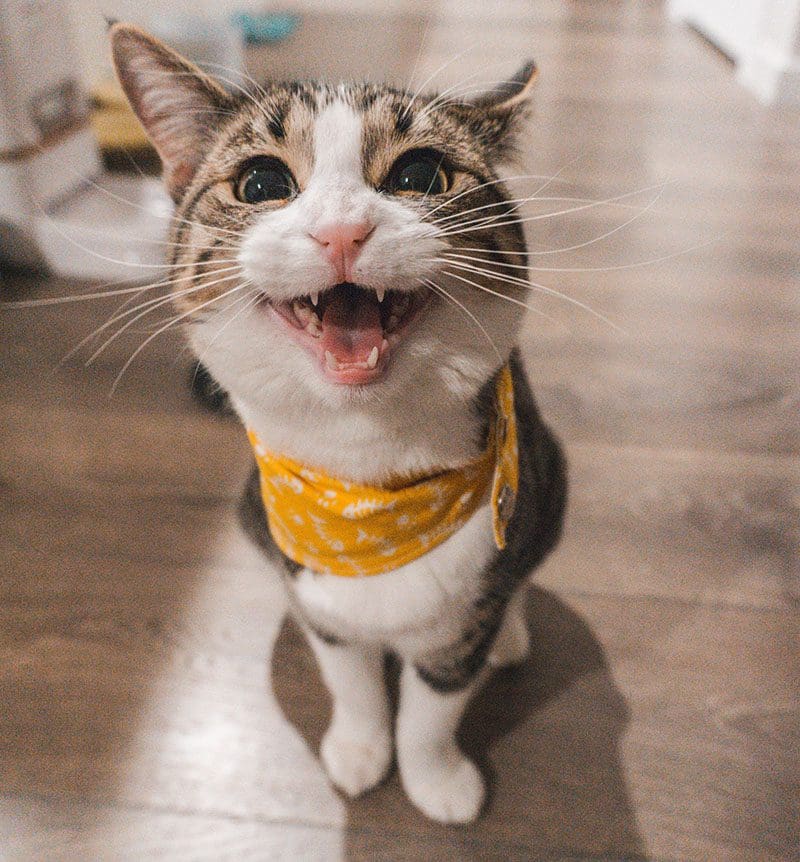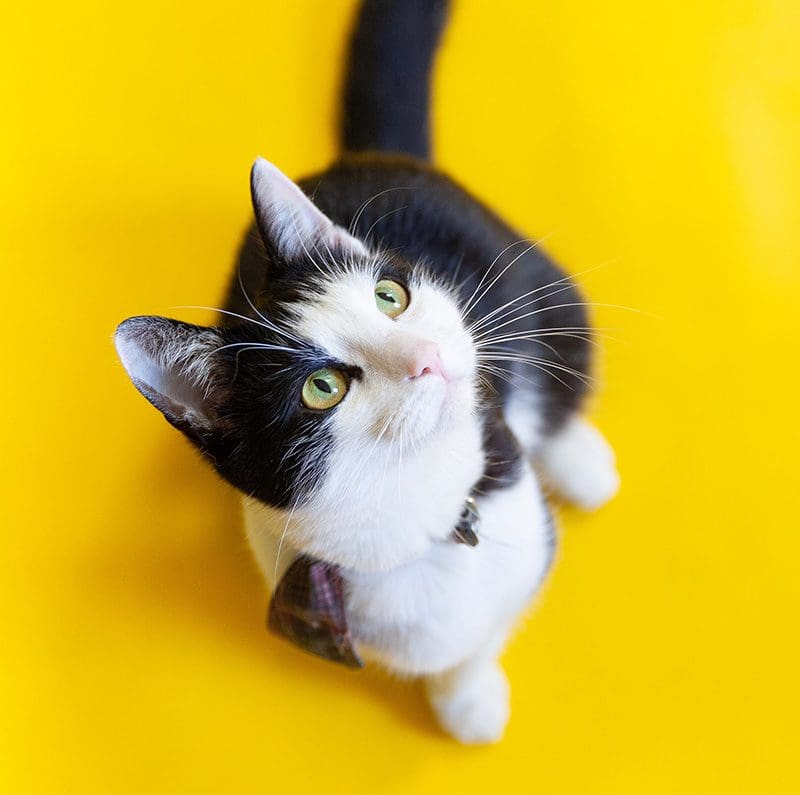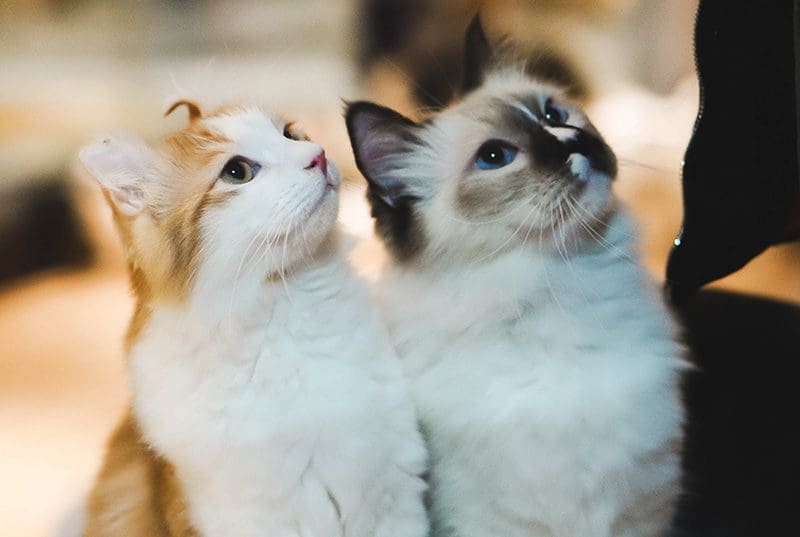
Does your cat suffer from cat anxiety, hyperactivity, or other behavioral issues? As a professional cat groomer, I am frequently asked how to calm a cat down. In order to help with that, I wrote this article so that you can find healthy ways to calm your cat down.
With nearly 60 million pet cats in the United states, they are the most commonly surrendered pet to shelters. Unwanted behavior is one of the most common reasons for these cats to be given up.
The good news is that there are several quality products and strategies for a variety of cat anxiety situations. Please read on to learn about some of the best calming aids for cats that I’ve found over the years.
In this Article We Cover:
- What Causes Cat Anxiety?
- How to Calm a Cat Down: Products and Tips
- When Do Kittens Calm Down?
- Will Neutering a Cat Calm Him Down?
- Little Lions
What Causes Cat Anxiety?
In order to learn how to calm a cat down, it’s good to know what causes cat anxiety in the first place.
As a cat groomer and behavior consultant, I find that many people are surprised that cats need training, socialization, and a strong foundation for coping with stress and changes in their environment – just as much as any dog!
Cat Anxiety Can Cause the Following Behaviors:
When cats have anxiety, they can exhibit a range of undesirable behavior such as:
- Litter Box Issues
- Excessive or Inappropriate Scratching and Biting
- Issues Around Children
- Issues with Other Pets
- General Aggression and Hyperactivity
So what causes cat anxiety? Well, two of the most common causes are medical issues and the cat’s environment.
Cat Anxiety from Medical Issues
We all experience some anxiety when we’re not feeling well. Cats are the same! Before introducing anything new or making environmental changes, your cat should see a licensed vet to make sure that their behavior troubles are not medically significant. Then, any changes should be very gradual.
Often, something in the environment can be causing your cat to have stress. Talk to your vet to help troubleshoot potential causes. Medical issues should be addressed first before any other changes happen. Your vet may discuss anti-anxiety medications with you. Medication can help relieve your cat’s stress while you start to improve the cat’s home environment.
Cat Anxiety from the Environment

Break your home into sections and think like a cat. Where would your cat like to eat? Where would they be most comfortable sleeping? What about a safe place to go to the bathroom? Are there enough places to hide and play?
Walk through your home and think about what it’s like for your cat to move around. Have you ever noticed any places where your cat seemed uncomfortable or felt trapped?
Cats are a territorial species and they prefer to have comfortable vantage points and well-planned passageways to traverse their domestic jungle.
Changing things too quickly or without considering your cat’s preferences can cause additional stress so take some time up front to think like your cat!
Building Trust Reduces Cat Anxiety
It’s very important to work on improving your relationship with your cat. You need to build trust with your cat and also learn to understand and respect your cat’s body language. This will go a long way towards keeping your cat’s stress to a minimum.
If you suppress natural cat behaviors, this will often lead to trouble. So, if you declaw your cat or punish unwanted behavior with a spray bottle or other method, this can create cat anxiety issues.
Your goal is to provide healthy and appropriate outlets for your cat’s natural behaviors.
This is the key to life-long cat harmony.
Please keep reading for some great ideas and products to reduce stress and anxiety for both you and your cat.
How to Calm a Cat Down: Products and Tips

My clients will often ask me what products I buy for my own pets. I signed up for the Amazon Associate Program so that I can include Amazon product links in this article.
If you click on a link below and make a purchase, I will receive a small commission at no extra cost to you. I truly appreciate this as it helps me to continue my mission to provide pet wellness education. Thank you so much!
The Art of Cat Calming
There are some great products available that are designed to help take the edge off of cat anxiety.
Since cat anxiety is often at the root of many cat behavior issues, you can definitely help both you and your cat by introducing some of these products into your cat’s home environment.
Cat Stress Relief Using Cat Furniture
- Amazon Basics Cat Tree with Platform
- Hey-brother 60 inches Multi-Level Cat Tree Condo Furniture
- FEANDREA Cat Tree for Large Cats
- Speedy Pet Collapsible Cat Tunnel
- Nature’s Miracle High-Sided Litter Box
Perches throughout the home provide a feeling of security for most cats as they’ll naturally want to survey territory from above and watch for any intrusions.
The Amazon Basics Cat Tree with Platform provides a basic perch if you’re just starting out, but eventually, many cat custodians find themselves collecting cat towers once they find the joy and comfort they provide.
I like the Hey-brother 60 inches Multi-Level Cat Tree Condo Furniture because it has scratching posts that allow your cat to get a full stretch when scratching. It also provides a height that is closer to the ceiling which many cats crave.
Cats Need a Little “Me Time” to Relax and Calm Down
You want any cat furniture to serve several functions such as a way to get from one space to another without feeling exposed, perching, play, and scratching. Having their own territory helps cats to feel more secure and provides stress relief!
For ground dwelling cats, as some seem to prefer to stay rooted on the floor, various tunnels and comfortable low-lying hides will allow them to mimic the wild instinct of hiding in the underbrush.
The FEANDREA Cat Tree for Large Cats is great even for portly chonks, and provides some scratching stress-relief.
The tunnels like the Speedy Pet Collapsible Cat Tunnel are always popular with my own pride of voids and chonks.
A Little Cat Privacy Please!

Your cat should have a spacious litter box located in a quiet, but easily accessible area. A good one is the Nature’s Miracle High-Sided Litter Box because it has high sides and a low-entry point. This is great for the oldies and teenies alike.
Personally, I’m not a big fan of covered litter boxes, but some cats may find them cozy. Covered boxes, along with scented litters, are not usually appealing to cats’ sensitive noses and wary tendencies.
I have one litter box per cat, plus one more. This allows for every cat to have a choice should one box wind up becoming inaccessible or negatively associated in some way.
Cat Calming Toys
- Go Cat Da Bird Single Pole Teaser
- AUOON Cat Scratcher Toy
- Mankaide 5 Packs in 1 Cat Scratch Pad
- KONG Cat Cozie Kickeroo Catnip Toy
Be sure to provide some playtime and attention, particularly around dawn and dusk when cats are naturally active. My go-to for interactive toys is the Go Cat Da Bird Single Pole Teaser on 36 inch Rod.
The most acrobatic cats will have a blast with this one as you mimic a bird in flight that they can bat to the ground.
Once it hits the ground, you can make it appear “injured” just before they go in for the kill. Whenever you play with your cat, try to imitate natural prey with the toy.
Give your cat ample opportunity to “win” and deliver the satisfying kicks and bites that they would use on prey. If you don’t let them succeed at the hunt, this will frustrate them and add to their stress. It may also teach them not to play at all.
A good toy for a hunter with an on-the-go family might be the AUOON Cat Scratcher Toy with several toys attached to a scratching pad that also allows for the natural and enriching use of claws.
Cats Need to Scratch to Calm Down
My most popular purchase with all of my cats is the Mankaide 5 Packs in 1 Cat Scratch Pad.
Rubbing catnip on scratchers and placing them where cats have shown an interest in scratching will encourage appropriate use of claws and save your furniture and doorways.
A helpful tip is to choose a scratcher that matches your cat’s scratching preference. For example, if your cat seems to enjoy scratching upright surfaces, then choose a scratcher with that orientation.
Remember that scratching is a necessary and emotionally fulfilling behavior for cats, so it should be redirected and given a healthy outlet if they’re attempting to scratch inappropriate objects.
Declawing should not be considered as this will lead to a multitude of other issues, both health and behavioral, as it permanently impairs the cat from performing natural behaviors which increases stress and frustration.
Suppressing natural behavior usually leads to worse behaviors. Instead, provide a wide selection of healthy outlets for your cat such as toys, perches, hides, scratching posts, and daily interaction.
This will help to calm a stressed or anxious cat and can even calm a hyperactive kitten.

How to Calm Your Cat when a Play Session Gets Too Rough
If your cat ever seems overstimulated and is pouncing or biting you, calmly fold your hands into your armpits and take a timeout to allow your cat a few minutes to calm down.
Providing a toy to wrestle with is usually a good redirection. I like to keep the KONG Cat Cozie Kickeroo Catnip Toy handy for tossing at a kitten-turned-wildling.
If they start nipping hands I have the toy “jump” onto them like another kitten joining the fun while my own hands become still and boring.
Make sure your cat has a good session before you go to bed and then provide them with their dinner to calm your cat down at night.
This will encourage them to sleep through the night since their inner beast should be placated until morning (hopefully).
Calming Cat Treats and Food
- Real Mushrooms Calming Chews for Dogs and Cats
- Kinpur Pet Care Cat Calming Treats
- ORIJEN Freeze Dried Cat Treats
A few tasty treats given to your cat during play sessions, like ORIJEN Freeze Dried Cat Treats, will complete their hunting session, and give them satisfying protein in a more natural state than what they might find in kibble or canned food.
Provide your cat with a healthy, high-quality diet. Supplement that with an array of interesting treats to allow for all-important mental stimulation and puzzling. This will more fully satisfy your cat or kitten and also exercise their body.
Frequent and shorter sessions of play, eating, and rest will be more effective than doing marathon sessions once in a while. Make sure to choose times that a cat would feel most frisky! Cats are crepuscular, meaning active at dawn and dusk.
How to Calm a Cat Down at Meal Time
- Stainless Steel Elevated and Tilted Cat Bowl
- VOLUAS Automatic Programmable Cat Feeder
- Sure Petcare Microchip Pet Feeder
- Tomxcute Cat Water Fountain
For mealtimes, I love the Stainless Steel Elevated and Tilted Cat Bowls.
These help to improve digestion and reduce neck strain by raising your cat’s face to a more comfortable eating position. The bowl is wide enough to prevent whisker fatigue and the stainless steel is easy to clean.
Providing reliable mealtimes is very reassuring to a cat. The VOLUAS Automatic Programmable Cat Feeder holds 4 liters of food and can provide your cat with their regular meals even if you are working late or are out on the town.
The Sure Petcare Microchip Pet Feeder is great if you have multiple pets with their own nutritional needs. Your cat will need a microchip for that to be useful, but an identifying microchip is a good idea for any cat!
Make sure your cat’s food and water are easily accessible. They should be in a place that your cat seems comfortable hanging out in, up high usually, where the family dog or toddlers can’t disturb them while they let their guard down to eat.
If your cat prefers a water fountain, I really love the Tomxcute Cat Water Fountain. Make sure to clean water fountains thoroughly to prevent potential bacterial build up.

Cats Prefer to Have Their Own Bowls
Cats should have their own bowls, even in multi-cat homes to decrease the stress that can come with competition over resources. I recommend using multiple water bowls or fountains, preferably made of stainless steel, and that the water is not chlorinated and refreshed at least daily.
All bowls should be sanitized at least weekly to prevent unpleasant odors and bacteria that could make your cat sick or at the very least cause them to find their food and water unpalatable.
Using Happy Pheromones as a Cat Stress Reliever
- FELIWAY Optimum Cat Enhanced Calming Pheromone Diffuser
- Comfort Zone 1 Pack Cat Calming Pheromone Collar for Cats
- FELIWAY Classic Calming Spray
A FELIWAY Optimum Cat Enhanced Calming Pheromone Diffuser mimics the happy pheromones cats have in the “happy” scent glands located in their face. After a month or two of use, you might find your cat has less of an “edge.”
Cat stress relief can also come in the form of a collar, such as the Comfort Zone 1 Pack Cat Calming Pheromone Collar for Cats. However, collars should only be used in cases where a cat won’t get it caught on something because that could result in injuries.
Many cats also find collars uncomfortable and they can be prone to matting fur around the neck- a groomer’s bane! So instead, I usually recommend the use of the diffuser on each level of the house and the regular, but measured, use of delicious cat calming treats or supplements.
You can also add a spritz of FELIWAY Classic Calming Spray to your cat furniture to make them feel even more at home.
I use cat towers, hides, and perches strategically in my house to eliminate bottlenecks in entryways, and deadend hallways so nobody can be a bully and prevent a shyer cat from getting where they want to go.
How to Calm Down a Cat in the Car
- Petmate Two Door Pet Kennel
- SnooZZy Sheepskin Bolster Crate Mat
- FELIWAY Classic Cat Calming Pheromone Travel Spray
Another time that cats can be very stressed is in the car going to the vet or groomer. Make sure they can travel safely and comfortably in a carrier, since even a leashed cat can be caught in a predicament when they travel.
I love carriers with at least two doors, like the Petmate Two Door Pet Kennel. The carrier should be about 1.5 times the length of your cat minus their tail.
I always line the bottom with something soft and absorbent like a towel or SnooZZy Sheepskin Bolster Crate Mat and keep a spare for if one of my cats has an accident during their trip.
A soft, non-slip surface also gives your cat something to nestle into and grip, providing additional feelings of security.
A spritz of FELIWAY Classic Cat Calming Pheromone Travel Spray can help your cat settle a bit. It is important to practice loading them into the carrier, even if you don’t take them out of the house.
Provide lots of tasty treats and make sure the introduction to the carrier is slow and gradual so they form a positive association and feelings of safety when they see it.
Short Practice Trips Can Calm Down a Cat in the Car
The same should be done for car travel. Take very short trips around the block and then head on home a few times a week and your cat can start to feel like a car ride isn’t such a big deal.
To calm your cat while at the vet, make sure your vet and groomer are providing as low-stress an experience as possible. If something seems beyond-bearable for your cat, and it isn’t a necessary procedure, consider waiting until your cat can be better acclimated to the process with training and behavior modification.
If it’s necessary, and your cat seems too stressed, veterinarians are now promoting the force-free approach of sedating fractious or fearful pets for necessary but simple procedures.
For example, a nail trim may be needed immediately for overgrown nails and training can take months. So, with sedation, you can take care of the medical concerns first and then begin training after they are comfortable and feeling better.
All training should be positive and reward-based to make sure to alleviate the stress that goes along with any procedure or interaction.

Additional Cat Calming Tips
I LOVE the product KIDS ‘N’ PETS – Instant All-Purpose Stain & Odor Remover for dissolving any possible accidents and to deodorize to reduce the likelihood of it happening again. I use this stuff on everything, for everything.
To keep my dogs from the cat resting areas, cat food, or litter boxes (yuck!), I use security chains or something like TheDoorLatch Childproof Cat Door Stopper.
This gives my cats safe areas to retreat from their doggy siblings when they need a break.
Avoid Topping off the Litter Box – Your Cat Will Thank You
I don’t top litter off. As I scoop, and the litter is reduced to a certain point, I’ll dump the remainder, clean the box, and then fill with fresh litter. The clean boxes make for happy cats.
Cats usually prefer a freshly filled box, so keeping the box scooped daily and scrubbed with a mild detergent a few times a month during litter changes will keep a lot of issues at bay.
I recommend having a litter box on each level of your home, particularly for aged cats. Kittens should not have free access to the entire home until they learn where the litter boxes are. Most kittens will naturally take to litter boxes and they usually won’t require the “training” that puppies do.
Litter box issues are often an indicator of a health issue, so be sure to ask your vet if your cat’s bathroom habits change. Cats often express anxiety or stress by urinating or defecating outside of the box, so it’s important to troubleshoot the cause of the issue, and not punish a cat for missing the box.
Is Cat TV Good for Cats?

Calming cat music is a favorite of mine for winding down before bed. “Cat TV” is popular on YouTube and the whimsyBirdy channel is one that I really enjoy. They also have a listing of bird videos for cats on their website. This can entertain your cat in the morning while you get ready for the day.
Cats really seem to enjoy the visual stimulation of watching cat tv. Just be sure to keep an eye on them when you are first introducing it. Many cats will sit calmly and enjoy the show, but some might take a few swings at your screen!
So, it’s best to watch cat tv along with your cat if you can. You’ll be surprised by how relaxing the videos can be and it makes for a great background while using your phone or tablet.
When Do Kittens Calm Down?
If you have an overactive kitten or young adult cat, you may not want to hear this, but that is often normal cat behavior.
They will begin exploring the world, which may only be the inside of your home to them. During this time, they can be quite acrobatic and chaotic.
It is up to you to provide an enriching and safe environment for them to learn how to “cat.” They will grow up quickly, so play with them often and enjoy every minute!
Will Neutering a Cat Calm Him Down?
You might be wondering does neutering calm a cat down? Or, will spaying calm a female cat?
The answer is: If your cat’s behavior is related to sex hormones, then neutering can calm them down.
Spaying is the term used for female cats, and it is more involved than castrating a male cat.
“Neuter” can refer to the procedure done on a male or female.
If your vet deems your cat to be healthy and old enough for the procedure, then I am a strong advocate for spaying and neutering cats for a multitude of reasons – unwanted litters and pet over-population aside.
Unaltered cats tend to be more likely to roam, and generally have more behavioral quirks that can’t be trained out of them. Territorial spraying, yowling, and fighting with other cats are just some of the issues that can crop up.
It is not necessary for a cat to have a heat cycle or to have a litter before they’re fixed.
Cats can have a litter when they are as young as three to four months old. So, it’s imperative to make sure they are kept strictly indoors until they are altered (and then even after that to protect wildlife). An unaltered female cat may attract male cats to your property while she is in season.
I recommend scheduling the appointment as soon as you acquire a new cat. That way you won’t have too long to wait if your cat starts spraying doorways or developing other unsavory habits that can arise from raging hormones.
Little Lions

It really isn’t too much of a stretch to think of our beloved cats as little lions. They love us very much, but they also have a wild side and they need healthy outlets for their natural behaviors and hunting instincts.
Remember to set up your cat’s home for stress-relief and easy access to resources. The vet should be your first call if you think your cat may have excessive stress or a behavior issue and medication can be a useful tool in helping your cat.
Providing healthy outlets, along with calming supplements, and a reliable schedule can help you relax a stressed cat or hyper cat. I wish you many happy, healthy years with your little lions!
Ready for More Cat Articles?
Please check out our Cat Blog for a full listing of all of our cat articles!
Join Our Mailing List!
We hope you enjoyed reading this article! The Absolute Animal Care Blog features articles that contain our best recommendations for dog and cat wellness, training strategies, and products.
Please join our mailing list to receive updates when new articles are released!
Photo of Cat with Green Background by Manja Vitolic
Cat Peering over Table Photo by Biel Morro
Photo of Cat with Yellow Bandana by Jae Park
Cat Under Blanket Photo by Mikhail Vasilyev
Kitten with Yellow Background Photo by Alicja Gancarz
Cat Licking Nose Photo by Lina Angelov
Four Cats in Kitchen Photo by Dietmar Ludmann
Two Cats Watching Cat TV Photo by Kelly
Little Lion Cat Photo by Anna Kozakova
